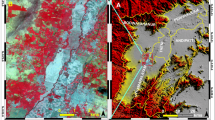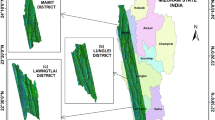Abstract
The work presented here showed a comprehensive evaluation of dual-polarimetric RISAT-1 data for land use/land cover (LULC) classification. The textural images were extracted with the help of gray-level co-occurrence matrix approach. Analysis of inter-class separability using transformed divergence method was performed to recognize the potential textural images. The best combination of textural images was also identified on the basis of standard deviation of preferred textural images and correlation coefficients. The maximum likelihood classifier-based classification results for different scenarios were compared. Furthermore, various classification algorithms, maximum likelihood classifier (MLC), artificial neural network (ANN), random forest (RF) and support vector machine (SVM), were performed on the best identified scenario in order to observe the most suitable algorithm for LULC classification. The combination of radiometric and their related textural images was found improving the overall classification accuracy than individual datasets. The highest overall classification accuracy was found using SVM (88.97%) followed by RF (88.45%), ANN (83.65%) and MLC (78.18%).









Similar content being viewed by others
References
Atkinson PM, Tatnall ARL (1997) Introduction neural networks in remote sensing. Int J Remote Sens 18(4):699–709
Breiman L (2001) Random forests. Mach Learn 45:5–32
Breiman L, Friedman J, Stone CJ, Olshen RA (1984) Classification and regression trees. Chapman and Hall/CRC, Belmont
Chakraborty M, Panigrahy S, Rajawat AS, Kumar R, Murthy TVR, Halder D, Chakraborty A, Kumar T, Rode S, Kumar H, Mahapatra M, Kundu S (2013) Initial results using RISAT-1 C band SAR data. Curr Sci 104(4):490–501
Chen D, Stow DA, Gong P (2004) Examining the effect of spatial resolution and texture window size on classification accuracy: an urban environment case. Int J Remote Sens 25(11):2177–2192
Congalton RG, Green K (1999) Assessing the accuracy of remotely sensed data: principles and practices. CRC/Lewis Press, Boca Raton
Cortes C, Vapnik VN (1995) Support-vector networks. Mach Learn 20:273–297
Das K, Paul PK (2015) Soil moisture retrieval model by using RISAT-1, C-band data in tropical dry and sub-humid zone of Bankura district of India. Egypt J Remote Sens Space Sci 18(2):297–310
Dixon B, Candade N (2008) Multispectral land use classification using neural networks and support vector machines: one or the other, or both? Int J Remote Sens 29(4):1185–1206
Foody GM (2009) Classification accuracy comparison: hypothesis tests and the use of confidence intervals in evaluations of difference, equivalence and non-inferiority. Remote Sens Environ 113:1658–1663
Haralick RM, Shanmugam K, Dinstein I (1973) Textural features for image classification. IEEE Trans Syst Man Cybern 3:610–621
Herold ND, Haack BN, Solomon E (2004) An evaluation of radar texture for land use/cover extraction in varied landscapes. Int J Appl Earth Obs Geoinf 5:113–128
Herold ND, Haack BN, Solomon E (2005) Radar spatial considerations for land cover extraction. Int J Remote Sens 26(7):1383–1401
Kavzoglu T, Mather PM (2003) The use of back propagating artificial neural networks in land cover classification. Int J Remote Sens 24:4907–4938
Kumar P, Gupta DK, Mishra VN, Prasad R (2015a) Comparison of support vector machine, artificial neural network and spectral angle mapper algorithms for crop classification using LISS IV data. Int J Remote Sens 36(6):1604–1617
Kumar P, Prasad R, Gupta DK, Mishra VN, Choudhary A (2015b) Support vector machine for classification of various crop using high resolution LISS-IV imagery. Bull Environ Sci Res 4(3):1–5
Kumar P, Prasad R, Choudhary A, Mishra VN, Gupta DK, Srivastava PK (2016a) A statistical significance of differences in classification accuracy of crop types using different classification algorithms. Geocarto Int. doi:10.1080/10106049.2015.1132483
Kumar P, Prasad R, Mishra VN, Gupta DK, Singh SK (2016b) Artificial neural network for crop classification using C-band RISAT-1 satellite datasets. Russ Agric Sci 42(3):281–284
Lee JS, Jurkevich L, Dewaele P, Wambac P, Oosterlinck A (1994) Speckle filtering of synthetic aperture radar images: a review. Remote Sens Rev 8(4):313–340
Li G, Lu D, Moran E, Dutra L, Batistella M (2012) A comparative analysis of ALOS PALSAR L-band and RADARSAT-2 C-band data for land cover classification in a tropical moist region. ISPRS J Photogramm Remote Sens 70:26–38
Liaw A, Wiener M (2002) Classification and regression by random forest. R News 2:18–22
Lillesand TM, Kiefer RW, Chipman JW (2008) Remote sensing and image interpretation, 6th edn. Wiley, New York
Lu D, Weng Q (2007) A survey of image classification methods and techniques for improving classification performance. Int J Remote Sens 28(5):823–870
Lu D, Mausel P, Batistella M, Moran E (2004) Comparison of land-cover classification methods in the Brazilian Amazon basin. Photogramm Eng Remote Sens 70(6):723–731
Luckman A, Frery AC, Yanasse CCF, Groom GB (1997) Texture in airborne SAR imagery of tropical forest and its relationship to forest regeneration stage. Int J Remote Sens 18:1333–1349
Mas JF, Flores JJ (2008) The application of artificial neural networks to the analysis of remotely sensed data. Int J Remote Sens 29:617–663
Mishra VN, Rai PK (2016) A remote sensing aided multi-layer perceptron-Markov chain analysis for land use and land cover change prediction in Patna district (Bihar), India. Arab J Geosci 9(4):1–18
Mishra VN, Rai PK, Mohan K (2014a) Prediction of land use changes based on land change modeler (LCM) using remote sensing: a case study of Muzaffarpur (Bihar), India. J Geogr Inst Jovan Cvijic 64:111–127
Mishra VN, Kumar P, Gupta DK, Prasad R (2014b) Classification of various land features using RISAT-1 dual polarimetric data. Int Arch Photogramm Remote Sens Spat Inf Sci XL-8:833–837
Misra T, Rana SS, Desai NM, Dave DB, Rajeevjyoti, Arora RK, Rao CVN, Bakori BV, Neelakantan R, Vachchani JG (2013) Synthetic aperture radar payload on-board RISAT-1: configuration, technology and performance. Curr Sci 104(4):446–461
Ndi Nyoungui A, Tonye E, Akono A (2002) Evaluation of speckle filtering and texture analysis methods for land cover classification from SAR images. Int J Remote Sens 23(9):1895–1925
Pal M (2005) Random forest classifier for remote sensing classification. Int J Remote Sens 26:217–222
Pijanowski BC, Brown DG, Shellito BA, Manik GA (2002) Using neural networks and GIS to forecast land use changes: a land transformation model. Comput Environ Urban Syst 26:553–575
Puissant A, Rougiera S, André S (2014) Object-oriented mapping of urban trees using random forest classifiers. Int J Appl Earth Obs Geoinf 26:235–245
Rajesh K, Jawahar CV, Sengupta S, Sinha S (2001) Performance analysis of textural features for characterization and classification of SAR images. Int J Remote Sens 22(8):1555–1559
Richards JA, Jia X (2006) Remote sensing digital image analysis, 4th edn. Springer, Heidelberg
Rodriguez-Galiano VF, Chica-Olmo M, Abarca-Hernandez F, Atkinson PM, Jeganathan C (2012) Random forest classification of Mediterranean land cover using multi-seasonal imagery and multi-seasonal texture. Remote Sens Environ 121:93–107
Sali E, Wolfson H (1992) Texture classification in aerial photographs and satellite data. Int J Remote Sens 13:3395–3408
Shiraishi T, Motohka T, Thapa RB, Watanabe M, Shimada M (2014) Comparative assessment of supervised classifiers for land use–land cover classification in a tropical region using time-series PALSAR mosaic data. IEEE J Sel Top Appl Earth Obs Remote Sens 7(4):1186–1199
Solberg AHS, Jain AK (1997) Texture fusion and feature selection applied to SAR imagery. IEEE Trans Geosci Remote Sens 35(2):475–479
Srivastava PK, Han D, Rico-Ramirez MA, Bray M, Islam T (2012) Selection of classification techniques for land use/land cover change investigation. Adv Space Res 50:1250–1265
Swain PH, Davis SM (1978) Remote sensing: the quantitative approach. McGraw-Hill, New York
Szuster BW, Chen Q, Borger M (2011) A comparison of classification techniques to support land cover and land use analysis in tropical coastal zones. Appl Geogr 31:525–532
Valarmathi N, Tyagi RN, Kamath SM, Reddy BT, Venkataramana M, Srinivasan VV, Dutta C, Veena N, Venketesh K, Raveendranath GN, Babu GRC, Prasad KS, Badagandi RR, Natarajan P, Sudhakar S, Subhalakshmi J, Rao S, Reddy MK (2013) RISAT-1 spacecraft configuration: architecture, technology and performance. Curr Sci 104(4):462–471
Vapnik VN (1998) Statistical learning theory. Wiley, New York
Vapnik VN (1999) An overview of statistical learning theory. IEEE Trans Neural Netw 10(5):988–999
Acknowledgements
The authors wish to gratefully acknowledge Prof. Rajeev Sangal Director, Indian Institute of Technology (B.H.U.), Varanasi, for providing financial support to procure ENVI-SARscape (v5.1) image analysis software. The authors would also like to express their deep sense of gratefulness to anonymous reviewers and editors for their valuable comments and suggestions that helped to improve the manuscript.
Author information
Authors and Affiliations
Corresponding author
Rights and permissions
About this article
Cite this article
Mishra, V.N., Prasad, R., Kumar, P. et al. Dual-polarimetric C-band SAR data for land use/land cover classification by incorporating textural information. Environ Earth Sci 76, 26 (2017). https://doi.org/10.1007/s12665-016-6341-7
Received:
Accepted:
Published:
DOI: https://doi.org/10.1007/s12665-016-6341-7




